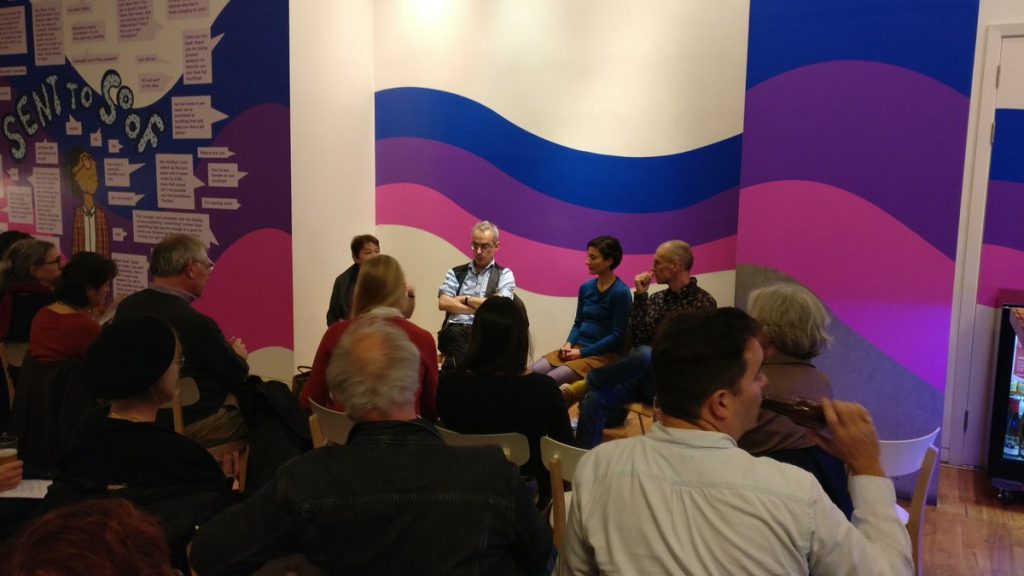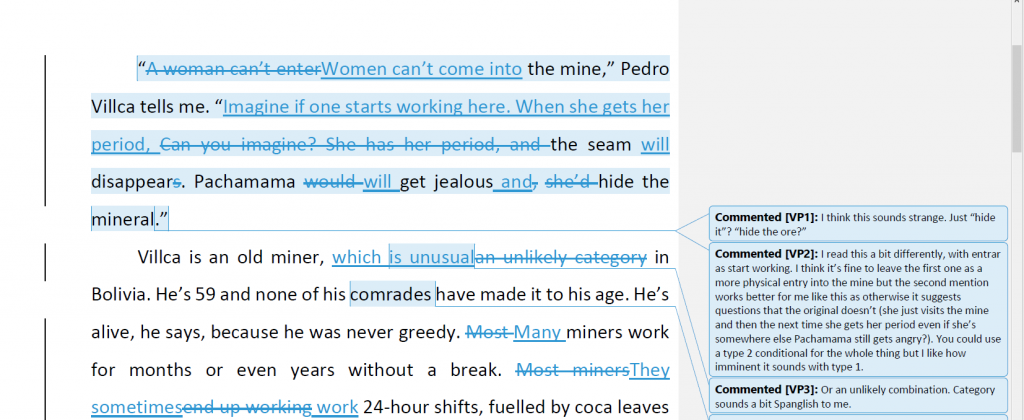I was recently invited to take part in a panel discussion organized for the Translators Association* on the topic of reviewing literary translations. Having spent much of 2018 earning myself a reputation as someone who was not afraid to voice unpopular ideas, I had been asked along to ensure that the proceedings were not too sedate.

I have to admit that I was expecting a torrid evening of being grilled for daring to criticize one of Ann Goldstein’s translations in the Guardian or for suggesting that, just maybe, literary translators shouldn’t be monstering Ben Moser on social media because he didn’t like a book that other people had enjoyed. Perhaps I would even be forced to defend the dastardly Tim Parks!
The evening was expected to address such questions as the following:
“How should reviewers critique translations? Who should do the reviewing? How do you assess a translation without knowledge of the source language? When does constructive criticism become destructive? How do you identify a ‘bad’ translation? What constitutes a ‘bad’ review? Is it pedantic to cherry-pick awkward choices, or necessary to support an opinion?”
I confess that such questions leave me at best indifferent and at worst suspicious. Who are we, as translators, to start issuing guidelines for reviewers? And are these questions, just possibly, merely a thinly veiled attempt to suppress negative commentary of any sort?
My own preference would be for us to embrace criticism, both from reviewers and from colleagues. Indeed, I would actually go further and say that self-criticism, the constructive criticism of colleagues, and the disinterested criticism of reviewers are absolutely essential for our professional development, and for creating authentic relationships with our peers and with our readers. The alternative is to live in a world of puff pieces and phoney praise.
But I knew that things were going to go well when Ros Schwartz, chairing the discussion, kicked off proceedings by quoting approvingly from Tim Parks’ latest article in the NYRB. (Okay. I’ll admit to a slight twinge of disappointment. I rather liked the idea that the English had become so soft that they’d been reduced to flying a Scotsman in from Spain whenever they wanted an argument. You can take the man out of Scotland…)
Instead of grappling with just where to draw the line between ‘good’ and ‘bad’ criticism, a consensus quickly emerged that literary translators have been far too sensitive about this issue recently, that it was time to grow up a little (grow a pair, even) and not get our knickers in such a twist whenever anyone says something vaguely negative about our work. (I suspect that if we’d been holding this event in the United States we might have spent longer – or even the whole evening – wallowing around in the swamp of policing precisely what criticism is and isn’t acceptable to the powers that be; thankfully, this was London, not New York.)
My fellow panel members – translator and editor, Sophie Lewis, and book reviewer, Nick Lezard – helped ensure that the debate was not marred by the oversensitivity that so often characterizes such discussion online. And perhaps the biggest contribution of all came from the audience, who moved affairs in a rather unexpected direction, one that just happens to coincide with my own particular passion (obsession even): the importance of peer review and collaborative working, to improve not just the quality of our translations but the quality of our professional relationships.
In that spirit, I would like to suggest three ways in which literary translators could incorporate criticism into their daily practice.
1. Start a three-way collaborative partnership
For the last two years, I’ve had an ongoing collaborative partnership with two colleagues: VictoriaPatience and Simon Berrill. We take turns to review and comment on each other’s work, we get together (via Skype) for a monthly translation slam, and we share advice and support via email and WhatsApp. It’s been a source of training, professional support and deep personal friendship, all rolled into one.
If you’re interested in exploring this idea, I’d suggest linking up with a couple of like-minded colleagues in your language combination. (They need to be people who you trust and respect, people who will share their work and their opinions honestly, people who will take and receive criticism in a constructive spirit.)
I’d then suggest sharing short excerpts from early drafts of your work. (The earlier the better, before you get locked into choices and interpretations.) Comment on these in the spirit of developmental editing – basically, identifying anything that is unusual, strange, interesting, impressive, and using that as the basis for discussion (either in the form of an annotated copy of the translation – or through email or via Skype). Here is an example of the incredibly helpful comments I received from Victoria on a first draft of a sample I translated when I was pitching Potosí for translation. (If you want to see the final English version – The Mountain That Eats Men – you’ll just have to buy the book.)

And, to keep it varied – and also just because it’s great fun – choose a text for all of you to translate once a month or so, then meet in person or via Skype to discuss it. If you love translation and enjoy talking about it but perhaps suffer from the isolation that can affect us all, this is really the best remedy. And there’s nothing like explaining why you’ve made certain choices and defending them against somebody else’s choices to really hone your skills.
We co-authored an article in the ITI bulletin about our partnership. And we also have a Facebook group to provide ongoing support for colleagues who’ve been inspired by our example. If you’re interested, please get in touch with me via my contact form or through social media.
2. Peer review in a safe online forum
This idea came out of the audience, and I think it probably needs a bit of collective input for it to happen. However, I guess it might operate along the following lines:
- any literary translator working into a given target language (English for most readers of this, I guess) joins a closed online forum, which is lightly moderated and open to approved members
- my preference would be for a closed group on Facebook, but it could also be a bespoke forum hosted elsewhere or even an email group
- members post a translation they are working on, along with the relevant source text, and invite comments
- I’d suggest sharing work at early (or even first) draft stage; obviously this is a question of preference, and I know some translators never share their early drafts, but against that I’d argue that it’s much easier to accept and incorporate criticism of work that is still a long way from being finalized
- other members of the group post their comments in the form of an annotated version of the translation
- these, together with the original translation, provide the basis for an ongoing discussion.
We’d obviously need some basic guidelines, but I think you could summarize these as follows: be respectful, be truthful, be helpful. (So no nastiness, but no empty praise either. And suggestions only if you think they would genuinely improve the translation.) Or, if you prefer the short version: don’t be an arsehole!
3. Bringing a critical edge to the translation slam
Translation slams have, quite rightly, grown in popularity over recent years, both for general audiences – at literary festivals and other events – and in more specialist contexts – within the framework of conferences, workshops and summer schools. (For anyone not familiar with the concept, a ‘translation slam’ is where two translators work on the same text, and present the results in front of a live audience, typically with a third translator chairing proceedings to keep the discussion on track. Sometimes with the author also involved. Audience participation optional.)
I think slams are a really powerful tool for engaging with members of the general public, and also provide a great platform for discussing our craft among ourselves. At such events, we generally (and understandably) avoid the notion that a translation slam is about comparison and criticism (whose translation is better, whose solutions are right or wrong), in favour of more open-ended discussion and appreciation.
But I do think that the notion of criticism, in the broadest sense, could help take translation slams to the next level. Here are a couple of suggestions:
Comparing a published translation with an unpublished alternative
When slamming for a general audience (e.g., at a literary festival), instead of just choosing an interesting piece from whatever book fits with the festival’s wider programme, what about comparing a published translation with an alternative version of the same passage? It’s quite likely that the published version (having been through more versions, editing and so on) would be better. And that in itself would be interesting and informative. And it would also be exciting for readers to see how even the ‘definitive’ translation reflects just one possible solution; to see how, in someone else’s hands, the whole book might have come out quite differently.
I know that some translators will be wary of the idea of exposing their work to this kind of scrutiny, but without such exposure it is impossible to truly engage readers. And I think we overestimate the risks. I’m pretty sure any minor loss of face caused by finding an embarrassing slip in your work or just feeling that you weren’t quite on point when producing that particular translation will be outweighed by the kudos and recognition you’ll earn from putting yourself out there in the first place. And that’s before we consider the huge benefits for your own skills and self-confidence that you get from taking part in such events.
Thematic slams
To add a bit of focus, I’d also suggest selecting a passage that embodies a particular challenge: dialogue, physical description, cultural references or whatever. That would help take the slam beyond just observing that “these translations are different” and would allow the audience to really see how translators solve problems, how these solutions may differ widely and, yes, how some solutions may indeed be more convincing than others. (This thematic slam could be combined with the ‘published vs. unpublished’ comparison suggested above, or used in the more traditional format of two translations which have both been produced from scratch for the purposes of the event.)
I think the thematic approach could be particularly good for events that occur within a professional context (conferences, workshops) but I also think that general audiences would appreciate it. If general audiences are already impressed by the fact that the different translations are, well, different, imagine how they’ll react if we open up the whole process a bit more, showing how we grapple with particular problems, how these problems are susceptible to different solutions – and how these solutions may vary. Hell, at this rate translators will be the new rock stars!
*Reviewing Translations, Translators Association, Free Word Centre, London. 13 November 2018. Organized by Charlotte Collins, Ruth Martin and Catherine Fuller.